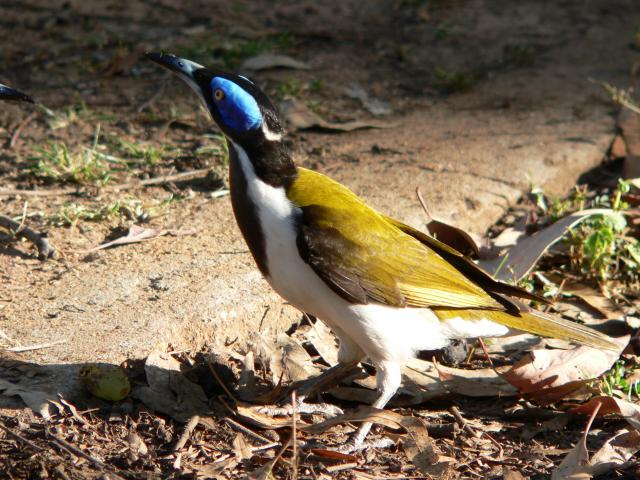- Blue-faced Honeyeater
Taxobox
name = Blue-faced Honeyeater
status = LC | status_system = IUCN3.1
status_authority = [IUCN2006|assessors=BirdLife International|year=2004|id=50833|title=Entomyzon cyanotis|downloaded=12 May 2006]

regnum =Animal ia
phylum = Chordata
classis = Aves
ordo =Passeriformes
familia =Meliphagidae
genus = "Entomyzon"
genus_authority = Swainson, 1825
species = "E. cyanotis"
binomial = "Entomyzon cyanotis"
binomial_authority = (Latham, 1802)The Blue-faced Honeyeater ("Entomyzon cyanotis"), also colloquially known as Bananabird, is apasserine bird of the Honeyeater familyMeliphagidae commonly found around the northern and eastern coasts ofAustralia andNew Guinea . The only member of its genus, it is most closely related to honeyeaters of the genus "Melithreptus ". Three subspecies are recognised. It is large for a honeyeater and easily identified by its bare blue face-patch. Found in open woodland, parks and gardens, its diet is made up of nectar and invertebrates.Taxonomy and naming
Originally described as "Gracula cyanotis" by ornithologist John Latham in 1802, though he also considered "Merops" (as "M. cyanops") and "
Turdus " (as "T. cyanous"). [Latham, J. (1802). "Supplementum Indicis Ornithologici, sive Systematis Ornithologiae." London: G. Leigh, J. & S. Sotheby 74 pp. [xxix] ] It is the only member of the genus "Entomyzon", though its plumage suggests an affinity with honeyeaters of the genus "Melithreptus ". It has been classified in that genus by Storr, [Storr, G.M., (1977) Birds of the Northern Territory. "Western Australian Museum Special Publication No. 7."] [Storr, G.M., (1984) Revised List of Queensland birds. "Records of the Western Australian Museum Supplement No. 19."] though others felt it more closely related to Wattlebirds ("Anthochaera ") or Miners ("Manorina "). [Schodde, R., (1975) Interim list of Australian Songbirds. Passerines. Royal Australasian Ornithologists Union, Melbourne.] A recent molecular study, however, has resolved it as close to "Melithreptus" after all. [Driskell, A.C., Christidis, L (2004) Phylogeny and evolution of the Australo-Papuanhoneyeaters (Passeriformes, Meliphagidae) "Molecular Phylogenetics and Evolution" 31 943–960]DNA analysis has shown honeyeaters to be related to thePardalotidae (pardalotes),Acanthizidae (Australian warblers, scrubwrens, thornbills, etc.), and theMaluridae (Australian fairy-wrens) in a largeMeliphagoidea superfamily. [Barker, F.K., Cibois, A., Schikler, P., Feinstein, J., and Cracraft, J (2004) Phylogeny and diversification of the largest avian radiation. "Proceedings Natl. Acad. Sci., USA" 101 11040-11045]The generic name is derived from the
Ancient Greek stems "ento-"/εντο- ("inside") and "myzein"/μυζειν "to drink" or "suck" while the specific name "blue-eared" comes from "cyano"-/κυανο "blue" and "otis"/ωτος Latinized genitive of "ous"/ους "ear".cite book | author = Liddell, Henry George and Robert Scott | year = 1980 | title =A Greek-English Lexicon (Abridged Edition) | publisher =Oxford University Press | location = United Kingdom | id = ISBN 0-19-910207-4] Other common names include Banana-bird, Pandanas-bird, White-quilled Honeyeater, Morning-bird, Blue-eye and Gympie. It is called "(minha) yeewi", where "minha" is a qualifier meaning 'meat' or 'animal', in Pakanh, "(inh -) ewelmb" in Uw Oykangand and Uw Olkola, where "inh-" is a qualifier meaning 'meat' or 'animal', in three aboriginal languages of centralCape York Peninsula .cite web | author = Philip Hamilton | title = blue-faced honeyeater, "Entomyzon cyanotis" | publisher = Australian Institute of Aboriginal and Torres Strait Islander Studies | date = 1997 | url = http://www.geocities.com/Athens/Delphi/2970/banana.htm | accessdate = 2007-07-04] Three races are recognized:
*"E. c. albipennis": described byJohn Gould in 1841 and found in north Queensland, west though the Gulf of Carpentaria in the Northern Territory and across into the top of Western Australia, [Gould, J. (1841). "In" Proceedings of meeting of Zoological Society of London, Dec. 8, 1840. "Proc. Zool. Soc. Lond. 1840": 168-178 [169] ] with white on the wings and a discontinuous stripe on the nape.
*"E. c. cyanotis": nominate race described below - found fromCape York Peninsula south through Queensland and New South Wales into the Riverina region.
*"E. c. griseigularis":From southwesternNew Guinea , described in 1909. [ Van Oort, E.D. (1909). Birds from south western and southern New Guinea. Nova Guinea Résultats de l'expédition scientifique Néerlandaise a la Nouvelle-Guinée. "Nova Guinea Zool." 9: 51-107 [97] .]Description
A large honeyeater 25-32 cm (9-13 in) in length, the adult Blue-faced honeyeater is easily recognised by its patch of bare blue skin around its eyes. The head and throat are otherwise predominantly blackish with a white stripe around the nape and another from the cheek. The underparts are white and the back and wings olive in colour. Juveniles are distinguished by their yellow or greenish face patches and dark brown rather than black on the head. The call is a "ki-owt". [cite book | author = Simpson K, Day N, Trusler P | title = Field Guide to the Birds of Australia | publisher = Viking O'Neil | date = 1993 | location = Ringwood, Victoria | pages = 392 | id = ISBN 0-670-90478-3]
Distribution and habitat
They live throughout open woodland,
pandanus ,paperbark s,mangrove s, watercourses,park s andgarden s. They are commonly known to suck the nectar out ofgrevillea trees and are very common around the backyard.Diet
Their diet consists of
pollen , berries,nectar , and cultivated crops such asbanana s or particularlygrape s, but the bulk of their diet consists ofinsect s. Usually very inquisitive, and friendly birds, they will often invade a campsite, searching for edible items.Reproduction
Blue-faced honeyeaters may nest from June to January, breding once or twice during this time. The nest is an untidy deep bowl of sticks and bits of bark in the fork of a tree, Birds Nest or
Staghorn Fern or deserted babbler nest. Two or rarely three eggs are laid, 22 x 32 mm (1 x 1⅓ in) and buff-pink splotched with red-brown or purplish colours. [cite book | last = Beruldsen | first = G | title = Australian Birds: Their Nests and Eggs | publisher = self | date = 2003 | location = Kenmore Hills, Qld | pages = 314 | doi = | id = ISBN 0-646-42798-9] It is one of the many bird species parasitised by theAsian Koel .References
External links
Wikimedia Foundation. 2010.
